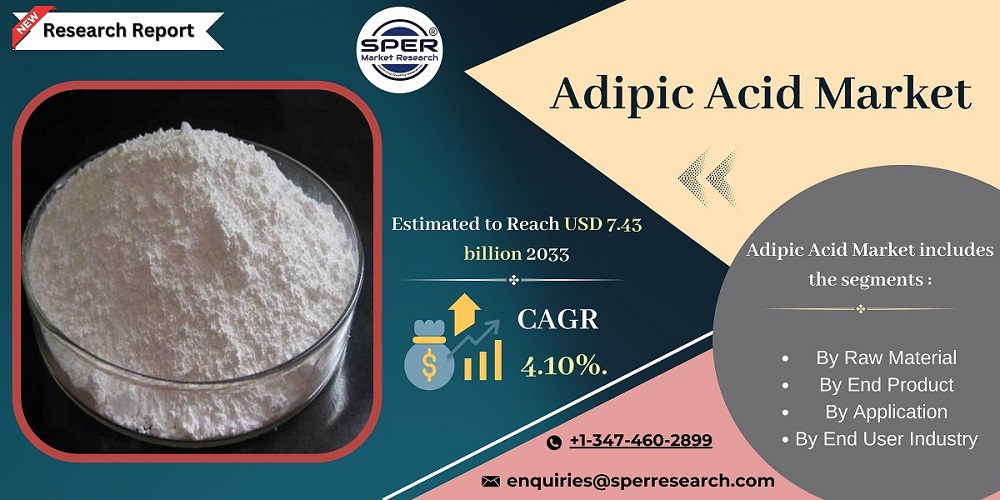Adipic acid, a colorless crystalline organic acid, is primarily produced by oxidizing a mixture of cyclohexanol and cyclohexanone with nitric acid. It is made up of cyclohexane and has widespread commercial applications. One of its major uses is as a key raw material in the production of Nylon 6,6, a vital polyamide in various industrial applications. In the past, it has been traditionally manufactured using petroleum-based substances like benzene, phenol, and cyclohexane. Adipic acid is available in different levels of purity, with lower purity grades being utilized in polyurethane manufacturing and higher purity grades being employed in nylon production.
According to SPER market research, ‘Adipic Acid Market Size- By Raw Material, By End Product, By Application, By End User Industry- Regional Outlook, Competitive Strategies and Segment Forecast to 2033’ state that the Global Adipic Acid Market is predicted to reach USD 7.43 billion by 2033 with a CAGR of 4.10%.
Several variables influence the global market for adipic acid. The first important driver is the rising demand for nylon 6,6, which is a major use for adipic acid. The need for adipic acid is fueled by the expansion of sectors like automotive, textiles, and consumer products, which use nylon 6,6 extensively. Additionally, as the demand for paints & coatings, wires & cables, and other applications that use adipic acid increases, growing economies like India, China, and Brazil are creating potential for the market.
The market, however, also confronts difficulties. The price volatility of raw materials, particularly feedstocks made from petroleum that are utilised to make synthetic adipic acid, is a significant obstacle. Another obstacle is the expensive manufacture of synthetic adipic acid. A transition towards bio-based alternatives has also been brought about by the negative environmental effects of petroleum-based adipic acid, such as the production of carbon dioxide and hazardous waste. Adipic acid produced from biomaterials cannot be widely used due to production costs and supply constraints. For the worldwide adipic acid market to expand and remain competitive, it will be essential to address these issues and promote sustainable production methods.
Request For Free Sample Report @ https://www.sperresearch.com/report-store/Global-Adipic-Acid-Market-Analysis.aspx?sample=1
Impact of COVID-19 on Global Adipic Acid Market
The COVID-19 pandemic had a substantial effect on the global adipic acid business. Key industries like automotive, textiles, and consumer goods saw a decrease in demand as a result of the limitations and interruptions brought on by the pandemic. The use of adipic acid declined as a result of the slowdown in manufacturing and building activities. But the market has begun to show indications of revival as limitations have been gradually loosened and economic activity has resumed. The global adipic acid market is anticipated to pick up steam in the post-pandemic period as industries recover and demand increases.
Adipic Acid Market Key Players:
Geographically, North America emerged as the dominant region in the adipic acid market. The strong economic stability in the region, particularly in the U.S., Canada, and Mexico, has resulted in higher purchasing power and disposable income among individuals, further boosting the demand for adipic acid. On the other hand, the Asia Pacific region presents lucrative growth opportunities in the adipic acid market. China, India, and the United States are key contributors to the global construction industry, with China leading in terms of growth. Additionally, some of the market key players are Asahi Kasei Corporation, Ascend Performance Materials, BASF SE, DOMO Chemicals, INVISTA, LANXESS, Liaoyang Tianhua Chemical Co., Ltd, Others.
Global Adipic Acid Market Segmentation:
By Raw Material: Based on the Raw Material, Global Adipic Acid Market is segmented as; Cyclohexanol, Cyclohexanone.
By End Product: Based on the End Product, Global Adipic Acid Market is segmented as; Adipate Esters, Nylon 66 Engineering Resins, Nylon 66 Fibers, Polyurethanes, Other End Products.
By Application: Based on the Application, Global Adipic Acid Market is segmented as; Coatings, Food Additives, Plasticizers, Synthetic Lubricants, Unsaturated Polyester Resins, Wet Paper Resins, Other Applications.
By End User Industry: Based on the End User Industry, Global Adipic Acid Market is segmented as; Automotive, Electrical and Electronics, Food and Beverage, Personal Care, Pharmaceuticals, Textiles, Other End-user Industries.
By Region: This report also provides the data for key regional segments of Asia-Pacific, Europe, Middle East and Africa, North America, Latin America, Others.
This study also encompasses various drivers and restraining factors of this market for the forecast period. Various growth opportunities are also discussed in the report.
For More Information, refer to below link: –
Adipic Acid Market Research Report
Related Reports:
Follow Us –
LinkedIn | Instagram | Facebook | Twitter
Contact Us:
Sara Lopes, Business Consultant – U.S.A.
SPER Market Research
+1-347-460-2899



